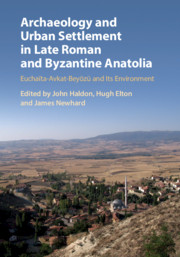 Archaeology and Urban Settlement in Late Roman and Byzantine Anatolia
Archaeology and Urban Settlement in Late Roman and Byzantine Anatolia Book contents
- Archaeology and Urban Settlement in Late Roman and Byzantine Anatolia
- Archaeology and Urban Settlement in Late Roman and Byzantine Anatolia
- Copyright page
- Contents
- Figures, Maps and Tables
- Contributors
- Preface
- A Note on Figures, Maps and Tables
- Abbreviations
- Introduction
- 1 Physical and Historical Introduction
- 2 Geology, Geomorphology and Palaeoenvironments
- 3 The Survey: Methods of Survey, Data Collection and Management and Artefactual Patterning
- 4 Travel and Communication
- 5 The Countryside
- 6 The Ceramics, Agricultural Resources and Food*
- 7 The Archaeology of the City and Its Hinterland
- 8 Euchaïta: From Late Roman and Byzantine Town to Ottoman Village
- Some Concluding Remarks
- Book part
- Bibliography
- Index
- References
Bibliography
Published online by Cambridge University Press: 09 November 2018
- Archaeology and Urban Settlement in Late Roman and Byzantine Anatolia
- Archaeology and Urban Settlement in Late Roman and Byzantine Anatolia
- Copyright page
- Contents
- Figures, Maps and Tables
- Contributors
- Preface
- A Note on Figures, Maps and Tables
- Abbreviations
- Introduction
- 1 Physical and Historical Introduction
- 2 Geology, Geomorphology and Palaeoenvironments
- 3 The Survey: Methods of Survey, Data Collection and Management and Artefactual Patterning
- 4 Travel and Communication
- 5 The Countryside
- 6 The Ceramics, Agricultural Resources and Food*
- 7 The Archaeology of the City and Its Hinterland
- 8 Euchaïta: From Late Roman and Byzantine Town to Ottoman Village
- Some Concluding Remarks
- Book part
- Bibliography
- Index
- References
- Type
- Chapter
- Information
- Archaeology and Urban Settlement in Late Roman and Byzantine AnatoliaEuchaïta-Avkat-Beyözü and its Environment, pp. 319 - 368Publisher: Cambridge University PressPrint publication year: 2018


